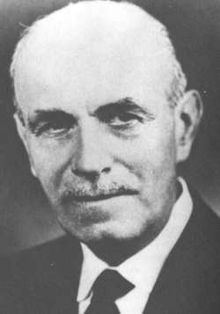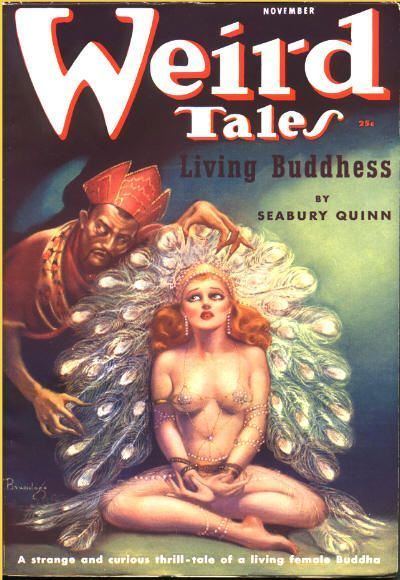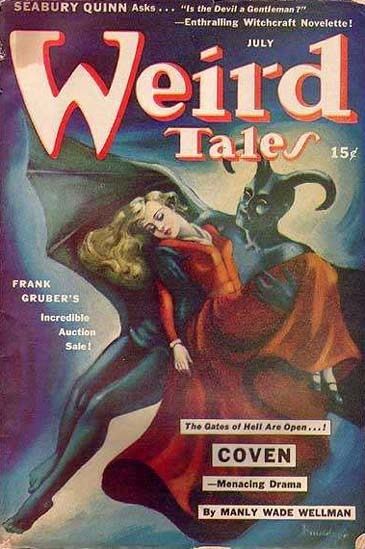Other names Jerome Burke Name Seabury Quinn | Role Author Died December 24, 1969 | |
 | ||
Born December 1889 Washington, D.C., USA Books The Devil's Bride, Pledged to the Dead, The Phantom Farmhou, The Man Who Cast No Shad, Roads Similar People Clark Ashton Smith, Edmond Hamilton, Robert Bloch, David H Keller, Robert E Howard | ||
The adventures of jules de grandin by seabury quinn book review
Seabury Grandin Quinn (also known as Jerome Burke; December 1889 – 24 December 1969) was an American pulp magazine author, most famous for his stories of the occult detective Jules de Grandin, published in Weird Tales.
Contents
- The adventures of jules de grandin by seabury quinn book review
- Pulp Crazy Roads by Seabury Quinn
- Biography
- References

Pulp Crazy - Roads by Seabury Quinn
Biography

He was born and lived in Washington, D.C. In 1910, he graduated from the law school of the National University and admitted to the District of Columbia Bar. He served in World War I; after his Army service he became editor of a group of trade papers in New York, where he taught medical jurisprudence and wrote technical articles and pulp magazine fiction.

His first published work was "The Law of the Movies", in The Motion Picture Magazine, December 1917. (His story "Painted Gold" may have been written earlier.) "Demons of the Night" was published in Detective Story Magazine on March 19, 1918, followed by "Was She Mad?" on March 25, 1918. He published "The Stone Image" in 1919. He introduced Jules de Grandin as a character in 1925 (taking the character's surname from his own middle name), and continued writing stories about him until 1951. The longest of the de Grandin stories is the 1932 novel-length story The Devil's Bride, strongly influenced by Robert W. Chambers' 1920 novel The Slayer of Souls.

In 1937 he returned to Washington to represent a chain of trade journals, and there subsequently became a government lawyer for the duration of World War II. He alternated between law and journalism all his life. He published over five hundred short stories.
His first book, Roads (a surprising new origin for Santa Claus, drawn from the original Christian legends), was published by Arkham House in 1948.
Ten of the Jules de Grandin stories were collected in The Phantom Fighter (Mycroft & Moran) (an imprint of Arkham House), 1966. A broader selection of the stories, including the novel The Devil's Bride, was issued in a six-volume Popular Library paperback edition in 1967-77. A three-volume omnibus reportedly including all the de Grandin stories was issued by a specialty publisher in 2002.
Although the De Grandin stories were enormously popular on their initial publication, modern critics tend to regard them as the weakest part of Quinn's work, with Brian Stableford describing the De Grandin stories "as indeed rather undistinguished", claiming they are full of stereotyped characters and poorly resolved plots. Quinn wrote several non-De Grandin tales in the 1940s and 1950s; Stableford states Quinn's "best stories here are ironically perverted love stories", such as "The Globe of Memories" (1937) and "Glamour" (1939).
His writing was secondary to his career as a lawyer specializing in mortuary jurisprudence. He taught this subject at mortuary schools for many years, and for some 15 years was the editor of Casket & Sunnyside, a leading trade journal. His Jerome Burke stories are still published in the Dodge embalming magazine.
Of his professional work only two slim books were published. The first is the infamouswhy is it 'infamous'? A Syllabus of Mortuary Jurisprudence, published in book form in 1933 by Clement Williams of Kansas City, Kansas. Foreword by C. A. Renouard of the Renouard School of Embalming, and Clement Williams of The Clement Williams School of Embalming. This was distilled from a lecture he gave in 1914. The text was extant as early as least 1924 / 1925, being serialized in Casket and Sunnyside. Quinn became editor of the Casket and Sunnyside in December 1925.
The second was An Encyclopedic Law Glossary For Funeral Directors and Embalmers. The Williams Institute of Mortuary Science, Kansas City 1940. Introduction by SQ, dated January 1940. This had a series of definitions of terms that had puzzled his students.
Besides contributing to the then De-Ce-Co Magazine, later the Dodge Magazine, for the Dodge Chemical Co, of Cambridge, Mass., articles were published in The American Funeral Director, and other trade journals. His Jerome Burke material, not necessarily in sequence, is available in This I Remember: Memoirs of a Funeral Director, and published by the Battered Silicon Dispatch Box, with a foreword by Arnold Dodge.
Quinn was a contemporary of Robert E. Howard, H. P. Lovecraft, and Clark Ashton Smith. Mary Elizabeth Counselman was a friend of Quinn's and wrote a tribute to him after he died.
Quinn's posthumously published novel Alien Flesh (1977) is a sexually explicit erotic fantasy about a male Egyptologist who has a magical sex-change into a beautiful young woman; it has been described as a " bold and striking celebration of sexual confusion" in the style of Pierre Louÿs. It was illustrated by Stephen Fabian.
A recent collection of stories by Quinn is Night Creatures, (2003) edited by Peter Ruber and Joseph Wrzos for Ash-Tree Press.
The latest collection of his stories is Demons of the Night, published by Black Dog Books, of Normal, Illinois. Edited by Gene Christie, it contains his early stories, including two of the Major Sturdevant and his Washington Nights' Entertainment series, subtitled Stories of the Secret Service, as well as two more featuring Professor Forrester, another amateur detector of crimes. It also contains one of the most complete bibliographies yet published.
